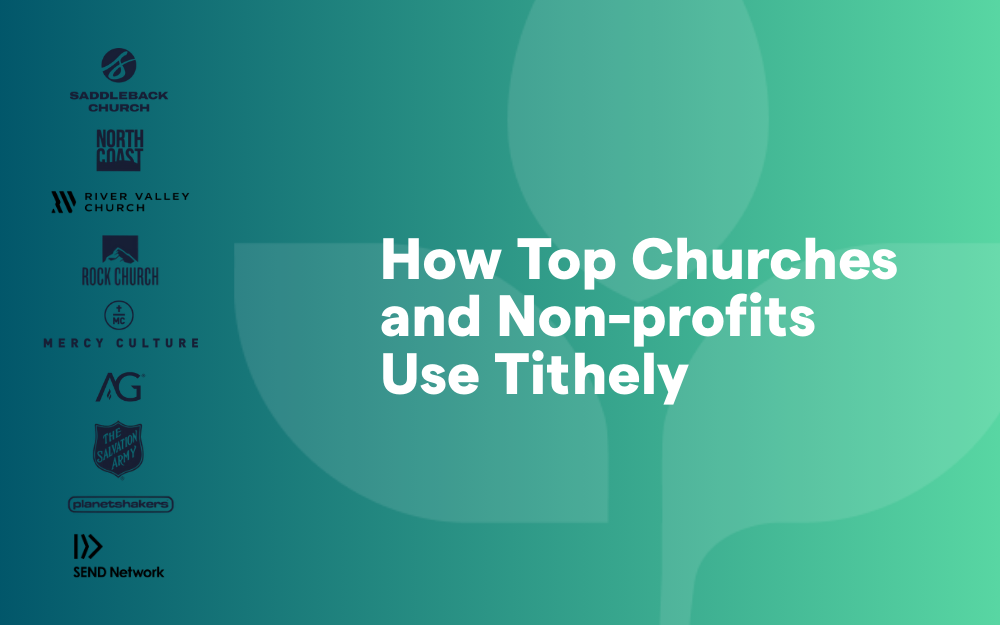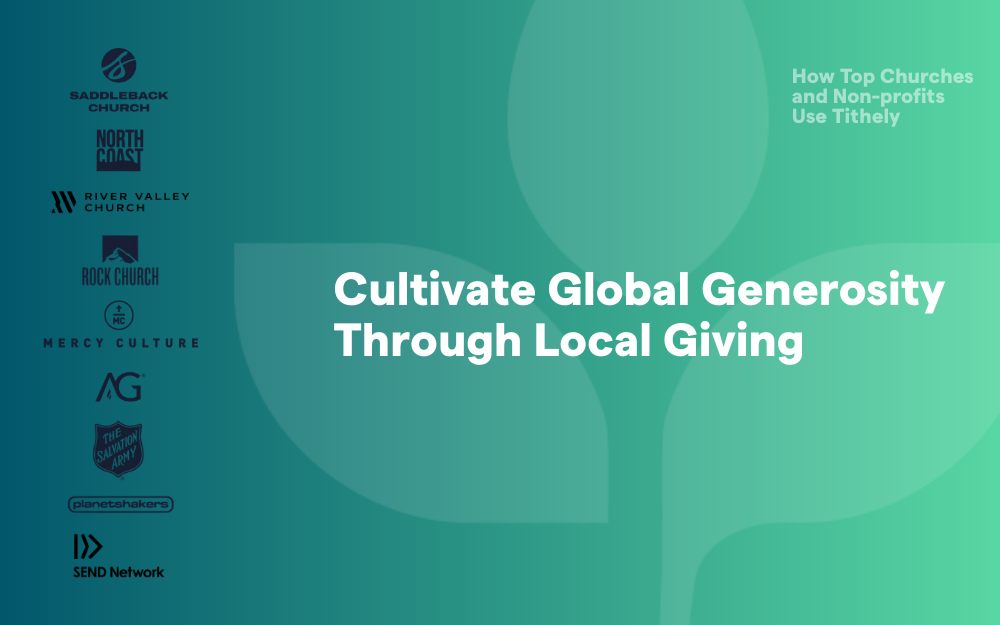Segmentation: The Key to Maximizing Year-End Giving
The magic of segmentation lies in its ability to facilitate tailored communication. Instead of a one-size-fits-all message, you can address the unique motivations, concerns, and aspirations of your different donors.

In our previous discussions, we delved into the importance of setting SMART goals and the intricacies of crafting a bespoke strategy for year-end giving. Today, we're diving deeper into a pivotal technique that can amplify your campaign's success: segmentation of your giver base.
Why Segmentation Matters
At its core, segmentation is the practice of dividing your donor community into distinct groups based on shared characteristics or behaviors, such as giving history, age, or engagement level.
The magic of segmentation lies in its ability to facilitate tailored communication. Instead of a one-size-fits-all message, you can address the unique motivations, concerns, and aspirations of each group. This personalized touch often leads to more meaningful engagement and, consequently, more generous giving.
Types of Givers
- Major Givers
These are the pillars of your donor community. They contribute significant amounts and often have the capacity and willingness to sponsor specific projects or initiatives.
- Regular Contributors
The backbone of your church's financial health, these members may not always give in large sums, but their consistent contributions provide stability.
- Occasional Givers
These donors contribute intermittently, often prompted by special events, holidays, or specific campaigns that resonate with them.
- New Prospects
These are the potential donors on the horizon. They've expressed interest in your church's mission, attended events, or engaged in other ways but haven't yet taken the step to contribute financially.
Strategies Tailored for Each Group
- Connect One-on-One with Major Givers
Foster deeper relationships through one-on-one meetings, exclusive events, or personalized communication. Discuss the broader impact of their contributions and explore opportunities for them to champion specific projects.
- Show Appreciation to Regular Contributors
Celebrate their unwavering support with acknowledgment letters, tokens of appreciation, or special mentions during services. Encourage them to deepen their involvement, perhaps by joining planning committees or becoming campaign ambassadors.
- Encourage Occasional Givers
Understand the triggers that motivate their giving. Design targeted campaigns or events that align with their interests, nudging them towards more regular contributions.
- Welcome New Prospects
Welcome them into the donor community with open arms. Offer easy ways to start contributing, such as micro-donations or volunteer opportunities. Showcase stories that demonstrate the tangible impact of even modest donations, inspiring them to join the cause.
Digital Strategies for Reaching Donors
By now, you know why segmentation matters and how to approach specific segments of donors. But what are the methods you can use to actually reach those donors? Here are three digital strategies for connecting with donors in a way that’s fast, effective, and cost-efficient.
- Text Messaging
Instant Engagement: With most people having their mobile phones within arm's reach, text messaging provides immediate access to your donors.
Text-to-Give: Implement a system where donors can easily contribute with a simple text. This method is especially effective for spontaneous giving during live events or services.
Updates and Reminders: Use text messages to send out timely reminders for upcoming campaigns, events, or milestones, ensuring your donor base is always in the loop.
- Pledge Campaigns
Commitment Over Time: Pledge campaigns allow donors to commit to giving a certain amount over a specified period, making it easier for them to contribute larger sums in manageable increments.
Digital Platforms: Use online platforms where donors can make, track, and adjust their pledges. This not only simplifies the process for the donor but also provides the church with a predictable revenue stream.
Progress Tracking: Offer digital dashboards where donors can see the collective progress of the pledge campaign, fostering a sense of community and shared purpose.
- Email Marketing
Segmented Campaigns: Just as you segment your donor base, segment your email lists. Tailor your messages to resonate with each group, whether it's major givers, regular contributors, or new prospects.
Engaging Content: Incorporate multimedia elements like videos, infographics, or testimonials to make your emails more engaging. A heartfelt video message from a church leader or a testimonial from a beneficiary can have a profound impact.
Clear Calls-to-Action (CTAs): Every email should have a clear and compelling CTA, whether it's to donate, attend an event, or share the campaign with friends and family. Make it easy for readers to take the desired action with prominent buttons and links.
Segment Your Audience with Tithely
Segmentation isn't just a strategy; it's a philosophy that recognizes the diverse tapestry of your donor community. By understanding and addressing the unique needs and aspirations of each segment, you can craft a year-end giving campaign that resonates deeply and authentically.
Coupled with SMART goals and a meticulously designed strategy, segmentation is your secret weapon to propel your church's mission and vision to unparalleled success.
If you’d like to learn more about how Tithely can help you segment your audience like a pro, check out Tithely Messaging.
Sign Up for Product Updates
In our previous discussions, we delved into the importance of setting SMART goals and the intricacies of crafting a bespoke strategy for year-end giving. Today, we're diving deeper into a pivotal technique that can amplify your campaign's success: segmentation of your giver base.
Why Segmentation Matters
At its core, segmentation is the practice of dividing your donor community into distinct groups based on shared characteristics or behaviors, such as giving history, age, or engagement level.
The magic of segmentation lies in its ability to facilitate tailored communication. Instead of a one-size-fits-all message, you can address the unique motivations, concerns, and aspirations of each group. This personalized touch often leads to more meaningful engagement and, consequently, more generous giving.
Types of Givers
- Major Givers
These are the pillars of your donor community. They contribute significant amounts and often have the capacity and willingness to sponsor specific projects or initiatives.
- Regular Contributors
The backbone of your church's financial health, these members may not always give in large sums, but their consistent contributions provide stability.
- Occasional Givers
These donors contribute intermittently, often prompted by special events, holidays, or specific campaigns that resonate with them.
- New Prospects
These are the potential donors on the horizon. They've expressed interest in your church's mission, attended events, or engaged in other ways but haven't yet taken the step to contribute financially.
Strategies Tailored for Each Group
- Connect One-on-One with Major Givers
Foster deeper relationships through one-on-one meetings, exclusive events, or personalized communication. Discuss the broader impact of their contributions and explore opportunities for them to champion specific projects.
- Show Appreciation to Regular Contributors
Celebrate their unwavering support with acknowledgment letters, tokens of appreciation, or special mentions during services. Encourage them to deepen their involvement, perhaps by joining planning committees or becoming campaign ambassadors.
- Encourage Occasional Givers
Understand the triggers that motivate their giving. Design targeted campaigns or events that align with their interests, nudging them towards more regular contributions.
- Welcome New Prospects
Welcome them into the donor community with open arms. Offer easy ways to start contributing, such as micro-donations or volunteer opportunities. Showcase stories that demonstrate the tangible impact of even modest donations, inspiring them to join the cause.
Digital Strategies for Reaching Donors
By now, you know why segmentation matters and how to approach specific segments of donors. But what are the methods you can use to actually reach those donors? Here are three digital strategies for connecting with donors in a way that’s fast, effective, and cost-efficient.
- Text Messaging
Instant Engagement: With most people having their mobile phones within arm's reach, text messaging provides immediate access to your donors.
Text-to-Give: Implement a system where donors can easily contribute with a simple text. This method is especially effective for spontaneous giving during live events or services.
Updates and Reminders: Use text messages to send out timely reminders for upcoming campaigns, events, or milestones, ensuring your donor base is always in the loop.
- Pledge Campaigns
Commitment Over Time: Pledge campaigns allow donors to commit to giving a certain amount over a specified period, making it easier for them to contribute larger sums in manageable increments.
Digital Platforms: Use online platforms where donors can make, track, and adjust their pledges. This not only simplifies the process for the donor but also provides the church with a predictable revenue stream.
Progress Tracking: Offer digital dashboards where donors can see the collective progress of the pledge campaign, fostering a sense of community and shared purpose.
- Email Marketing
Segmented Campaigns: Just as you segment your donor base, segment your email lists. Tailor your messages to resonate with each group, whether it's major givers, regular contributors, or new prospects.
Engaging Content: Incorporate multimedia elements like videos, infographics, or testimonials to make your emails more engaging. A heartfelt video message from a church leader or a testimonial from a beneficiary can have a profound impact.
Clear Calls-to-Action (CTAs): Every email should have a clear and compelling CTA, whether it's to donate, attend an event, or share the campaign with friends and family. Make it easy for readers to take the desired action with prominent buttons and links.
Segment Your Audience with Tithely
Segmentation isn't just a strategy; it's a philosophy that recognizes the diverse tapestry of your donor community. By understanding and addressing the unique needs and aspirations of each segment, you can craft a year-end giving campaign that resonates deeply and authentically.
Coupled with SMART goals and a meticulously designed strategy, segmentation is your secret weapon to propel your church's mission and vision to unparalleled success.
If you’d like to learn more about how Tithely can help you segment your audience like a pro, check out Tithely Messaging.
podcast transcript
In our previous discussions, we delved into the importance of setting SMART goals and the intricacies of crafting a bespoke strategy for year-end giving. Today, we're diving deeper into a pivotal technique that can amplify your campaign's success: segmentation of your giver base.
Why Segmentation Matters
At its core, segmentation is the practice of dividing your donor community into distinct groups based on shared characteristics or behaviors, such as giving history, age, or engagement level.
The magic of segmentation lies in its ability to facilitate tailored communication. Instead of a one-size-fits-all message, you can address the unique motivations, concerns, and aspirations of each group. This personalized touch often leads to more meaningful engagement and, consequently, more generous giving.
Types of Givers
- Major Givers
These are the pillars of your donor community. They contribute significant amounts and often have the capacity and willingness to sponsor specific projects or initiatives.
- Regular Contributors
The backbone of your church's financial health, these members may not always give in large sums, but their consistent contributions provide stability.
- Occasional Givers
These donors contribute intermittently, often prompted by special events, holidays, or specific campaigns that resonate with them.
- New Prospects
These are the potential donors on the horizon. They've expressed interest in your church's mission, attended events, or engaged in other ways but haven't yet taken the step to contribute financially.
Strategies Tailored for Each Group
- Connect One-on-One with Major Givers
Foster deeper relationships through one-on-one meetings, exclusive events, or personalized communication. Discuss the broader impact of their contributions and explore opportunities for them to champion specific projects.
- Show Appreciation to Regular Contributors
Celebrate their unwavering support with acknowledgment letters, tokens of appreciation, or special mentions during services. Encourage them to deepen their involvement, perhaps by joining planning committees or becoming campaign ambassadors.
- Encourage Occasional Givers
Understand the triggers that motivate their giving. Design targeted campaigns or events that align with their interests, nudging them towards more regular contributions.
- Welcome New Prospects
Welcome them into the donor community with open arms. Offer easy ways to start contributing, such as micro-donations or volunteer opportunities. Showcase stories that demonstrate the tangible impact of even modest donations, inspiring them to join the cause.
Digital Strategies for Reaching Donors
By now, you know why segmentation matters and how to approach specific segments of donors. But what are the methods you can use to actually reach those donors? Here are three digital strategies for connecting with donors in a way that’s fast, effective, and cost-efficient.
- Text Messaging
Instant Engagement: With most people having their mobile phones within arm's reach, text messaging provides immediate access to your donors.
Text-to-Give: Implement a system where donors can easily contribute with a simple text. This method is especially effective for spontaneous giving during live events or services.
Updates and Reminders: Use text messages to send out timely reminders for upcoming campaigns, events, or milestones, ensuring your donor base is always in the loop.
- Pledge Campaigns
Commitment Over Time: Pledge campaigns allow donors to commit to giving a certain amount over a specified period, making it easier for them to contribute larger sums in manageable increments.
Digital Platforms: Use online platforms where donors can make, track, and adjust their pledges. This not only simplifies the process for the donor but also provides the church with a predictable revenue stream.
Progress Tracking: Offer digital dashboards where donors can see the collective progress of the pledge campaign, fostering a sense of community and shared purpose.
- Email Marketing
Segmented Campaigns: Just as you segment your donor base, segment your email lists. Tailor your messages to resonate with each group, whether it's major givers, regular contributors, or new prospects.
Engaging Content: Incorporate multimedia elements like videos, infographics, or testimonials to make your emails more engaging. A heartfelt video message from a church leader or a testimonial from a beneficiary can have a profound impact.
Clear Calls-to-Action (CTAs): Every email should have a clear and compelling CTA, whether it's to donate, attend an event, or share the campaign with friends and family. Make it easy for readers to take the desired action with prominent buttons and links.
Segment Your Audience with Tithely
Segmentation isn't just a strategy; it's a philosophy that recognizes the diverse tapestry of your donor community. By understanding and addressing the unique needs and aspirations of each segment, you can craft a year-end giving campaign that resonates deeply and authentically.
Coupled with SMART goals and a meticulously designed strategy, segmentation is your secret weapon to propel your church's mission and vision to unparalleled success.
If you’d like to learn more about how Tithely can help you segment your audience like a pro, check out Tithely Messaging.
VIDEO transcript
In our previous discussions, we delved into the importance of setting SMART goals and the intricacies of crafting a bespoke strategy for year-end giving. Today, we're diving deeper into a pivotal technique that can amplify your campaign's success: segmentation of your giver base.
Why Segmentation Matters
At its core, segmentation is the practice of dividing your donor community into distinct groups based on shared characteristics or behaviors, such as giving history, age, or engagement level.
The magic of segmentation lies in its ability to facilitate tailored communication. Instead of a one-size-fits-all message, you can address the unique motivations, concerns, and aspirations of each group. This personalized touch often leads to more meaningful engagement and, consequently, more generous giving.
Types of Givers
- Major Givers
These are the pillars of your donor community. They contribute significant amounts and often have the capacity and willingness to sponsor specific projects or initiatives.
- Regular Contributors
The backbone of your church's financial health, these members may not always give in large sums, but their consistent contributions provide stability.
- Occasional Givers
These donors contribute intermittently, often prompted by special events, holidays, or specific campaigns that resonate with them.
- New Prospects
These are the potential donors on the horizon. They've expressed interest in your church's mission, attended events, or engaged in other ways but haven't yet taken the step to contribute financially.
Strategies Tailored for Each Group
- Connect One-on-One with Major Givers
Foster deeper relationships through one-on-one meetings, exclusive events, or personalized communication. Discuss the broader impact of their contributions and explore opportunities for them to champion specific projects.
- Show Appreciation to Regular Contributors
Celebrate their unwavering support with acknowledgment letters, tokens of appreciation, or special mentions during services. Encourage them to deepen their involvement, perhaps by joining planning committees or becoming campaign ambassadors.
- Encourage Occasional Givers
Understand the triggers that motivate their giving. Design targeted campaigns or events that align with their interests, nudging them towards more regular contributions.
- Welcome New Prospects
Welcome them into the donor community with open arms. Offer easy ways to start contributing, such as micro-donations or volunteer opportunities. Showcase stories that demonstrate the tangible impact of even modest donations, inspiring them to join the cause.
Digital Strategies for Reaching Donors
By now, you know why segmentation matters and how to approach specific segments of donors. But what are the methods you can use to actually reach those donors? Here are three digital strategies for connecting with donors in a way that’s fast, effective, and cost-efficient.
- Text Messaging
Instant Engagement: With most people having their mobile phones within arm's reach, text messaging provides immediate access to your donors.
Text-to-Give: Implement a system where donors can easily contribute with a simple text. This method is especially effective for spontaneous giving during live events or services.
Updates and Reminders: Use text messages to send out timely reminders for upcoming campaigns, events, or milestones, ensuring your donor base is always in the loop.
- Pledge Campaigns
Commitment Over Time: Pledge campaigns allow donors to commit to giving a certain amount over a specified period, making it easier for them to contribute larger sums in manageable increments.
Digital Platforms: Use online platforms where donors can make, track, and adjust their pledges. This not only simplifies the process for the donor but also provides the church with a predictable revenue stream.
Progress Tracking: Offer digital dashboards where donors can see the collective progress of the pledge campaign, fostering a sense of community and shared purpose.
- Email Marketing
Segmented Campaigns: Just as you segment your donor base, segment your email lists. Tailor your messages to resonate with each group, whether it's major givers, regular contributors, or new prospects.
Engaging Content: Incorporate multimedia elements like videos, infographics, or testimonials to make your emails more engaging. A heartfelt video message from a church leader or a testimonial from a beneficiary can have a profound impact.
Clear Calls-to-Action (CTAs): Every email should have a clear and compelling CTA, whether it's to donate, attend an event, or share the campaign with friends and family. Make it easy for readers to take the desired action with prominent buttons and links.
Segment Your Audience with Tithely
Segmentation isn't just a strategy; it's a philosophy that recognizes the diverse tapestry of your donor community. By understanding and addressing the unique needs and aspirations of each segment, you can craft a year-end giving campaign that resonates deeply and authentically.
Coupled with SMART goals and a meticulously designed strategy, segmentation is your secret weapon to propel your church's mission and vision to unparalleled success.
If you’d like to learn more about how Tithely can help you segment your audience like a pro, check out Tithely Messaging.




























